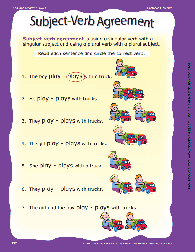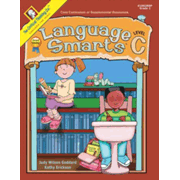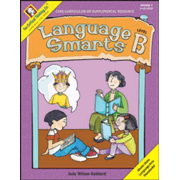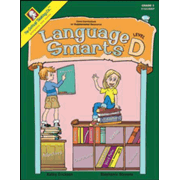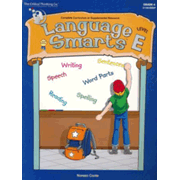The Critical Thinking Co.™ publishes Language Smarts, a language-arts series for the elementary grades, with Levels B, C, D, and E available for grades one through four, respectively. One large worktext (over 340 pages) for each level provides self-instructional student activity pages and has an answer key at the back. Each volume can serve either as your core curricula or as a supplemental resource.
In contrast to most language arts programs that can serve as core curricula, these books arrange lessons by topic, covering one area of language arts at a time. For instance, there might be a number of lessons on the parts of speech followed by a series of lessons on punctuation. An exception to this is the lessons taken from Editor in Chief® books (from the same publisher). Editor in Chief lessons appropriate for each grade level are scattered throughout all four books. Levels C, D, and E also add scattered lessons from the publisher's Writing Detective® series.
The lessons are presented in a variety of formats, with heavy doses of critical thinking skills incorporated from time to time. While there are many exercises that are similar to what you find in other courses—e.g., underlining words that belong to word families and circling the verb in each sentence—many lessons include some of the same innovative approaches that The Critical Thinking Co. has used in their other publications. Some of the Language Smarts reading comprehension lessons use formats similar to those in the Reading Detective® series, requiring students to identify the sentence in a passage that supports their answer. Level B inserts a few deductive-reasoning grid puzzles from the Mind Benders® series. In addition, lessons sometimes include word searches, crossword puzzles, and pictograms.
Brief instruction at the beginning of each lesson is followed by one or more practice pages. Students write directly in these consumable books.
The visually rich practice pages in Level B and Level C are likely to make completing the exercises more appealing to students. The graphic-design style changes for Level D and Level E. In the first two levels, the pages have colored, wavy frames and background shading within the frames. Level D has colored, rectangular frames around the pages, but no background shading. Level E is even less colorful than Level D. Levels B and C feature many more illustrations than you see in most language arts books. The illustrations in all of these books are a mix of styles, but there is a jarring mix of clip art styles in Level D. Level E has very few illustrations, so the style is irrelevant. While there's a significant difference in the appearance of the different levels, the books all have some full color, and the pages are not overly busy.
Details about Each Level
Level B for first grade begins with letters, short and long vowels, vowel digraphs and diphthongs, consonant blends, and other phonetic elements of words (pages 1 to 57). A substantial part of the book teaches about nouns, verbs, subjects, and predicates. Some of the other topics covered in this book are the articles a and an, syllables, word families, rhymes, contractions, verb tenses, comparative adjectives and adverbs, antonyms, synonyms, homophones, sequencing, deductive reasoning, capitalization, punctuation, reading skills, poetry, and descriptive writing.
Level C for second-grade reviews and expands upon concepts taught in Level B then adds topics such as prefixes, suffixes, roots, paragraphs, alliteration, folktales, the parts of a book, using the dictionary, and writing activities (e.g., friendly letters, giving directions, alternative story endings, and problem-solution paragraphs).
Level D for third grade again expands upon earlier concepts and adds alphabetizing, simple and compound sentences, conjunctions, common and proper nouns, adjectives, irregular verbs, similes, metaphors, identifying story plots, writing numbers with words, using reference materials, and the library. This level concludes by having students write a one-page research paper. The content seems less creative and less oriented toward critical thinking—many of the activities seem much like those in traditional language-arts workbooks but with more color.
While Level E for fourth grade reviews some concepts such as the parts of speech, sentence structure, and punctuation, it adds significant work in three areas: the use of reference resources, literary analysis, and composition skills. Some of the formats and techniques used here for composition lessons are the same as those in The Critical Thinking Co.'s Building Writing Skills® series.
Summary
Many of the Language Smarts activities are likely to be more interesting for students than the fairly predictable activities in most traditional language-arts workbooks.
(Note that Editor in Chief, Mind Benders, Reading Detective, and Writing Detective are the trademarked names of particular styles of activities created by The Critical Thinking Co. that are used in other resources they publish.)





